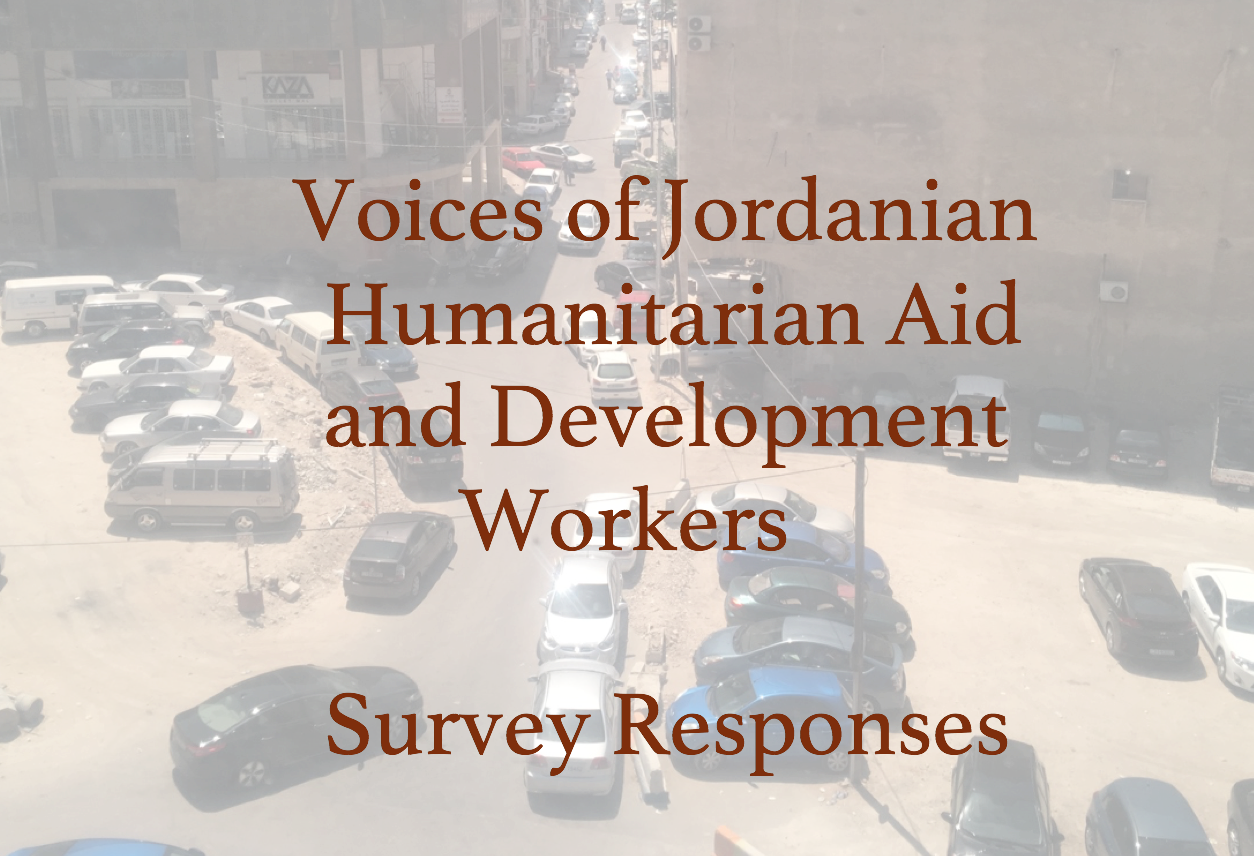“…respect their dignity first…”
-female Jordanian humanitarian
“Although I love my work, I do think this sector is very damaging and it must be scrutinized and criticized more often.”
-female humanitarian in the sector more than five years
How can humanitarian aid organizations be more effective in improving lives?
Prologue
I am very near the end of presenting and commenting on the results from the survey of Jordanian humanitarian workers, with just one or two posts remaining. My next step will be to summarize all the data in article form, so stayed tuned.
The larger context
Jordan has been receiving refugees for at least the last 70 years, and the impact of Syrian refugees on Jordan’s economic system, social services, educational institutions, and overall culture has been significant. In addition to the Jordanian government and UN agencies, there are threescore INGOs working in and around Amman, and countless other smaller national, regional, and international NGO’s addressing the needs of 1.2 million refugees. While I am not aware of any comprehensive sources about the humanitarian response in toto, a good guess is that there are close to 10,000 Jordanians employed in various capacities as part of this effort.
In sum, responding to the needs of affected communities is an enormous effort involving a complex array of organizations, thousands of workers, and affected communities that are far from static and homogeneous. Indeed, just the opposite is the case as political sands shift, donor attention spans wane, and the aid industry itself morphs and adapts in response to both internal and external pressures and feedback.
 One thing remains constant, though, and that is the chronic and dramatic gap between needs and resources available to meet those needs. “In 2018, UNHCR requirements to assist refugees in Jordan total $274.9 million. As of February 2018, UNHCR has received only $17.8 million in funding, equal to 6% of total needs.” (emphasis added)
One thing remains constant, though, and that is the chronic and dramatic gap between needs and resources available to meet those needs. “In 2018, UNHCR requirements to assist refugees in Jordan total $274.9 million. As of February 2018, UNHCR has received only $17.8 million in funding, equal to 6% of total needs.” (emphasis added)
Ouch.
Though what I am going to report below may sound -and, frankly, is- critical of the humanitarian aid and development sector, the objective reality cannot be forgotten. What is done, day in and day out, in support of marginalized individuals and communities by Jordanian (and other) humanitarians is no less that Herculean, a large scale effort perhaps unmatched in human history. Responding the waves of refugees is a massive, under resourced, and frequently misunderstood task that is no less than amazing in its professionalism, passion, and persistence. Lives are made better every day, and the proverbial needle is being pushed forward slowly, methodically, and in a demonstratively positive direction by the cumulative efforts of countless humanitarian souls. And, yes, the vast majority of these souls are Jordanians.
I’ll go one step further and point out that all the humanitarian good that is happening in and around Amman is matched in humanitarian crises around the globe in places like Erbil, Cox’s Bazar, Juba, Abs, and Bangui. Many critics argue that the humanitarian aid system is ‘broken’, but I don’t think it is that simple or negative, and I think using that language is dismissive of all the positive actions being taken every day by both individual humanitarians and the organizations for which they work.
Is the system perfect? No. One move in the right direction, though, is for the sector to listen to an array of voices with sober assessments and positive suggestions.
Listening to what national aid workers think is critical, and so now on to what they have to say.
How can organizations can be more effective in improving lives?
Question 41 on the survey was open ended, asking “What are your thoughts about how humanitarian aid and development organizations in Jordan can be more effective in improving the lives within the affected communities? That a total of 48 women and men took the time to write in responses at the end of a long survey -57% of the total respondents- tells me they wanted their opinions heard. So here they are.
One consistent theme throughout the comments was these aid workers felt humanitarian organizations need to engage in “More listening.” This young female worker had her sentiment repeated again and again in various phrasings by other respondents. Another female said, simply, “Activate feedback system from beneficiaries.”
Here are just a few more, many of which are quite clear on who needs to be engaged in the listening process.
“Implementing projects related to the true needs of the beneficiaries.”
“Humanitarian and development agencies need to play a major role in changing donor strategies which are sometimes restrictive and lack a certain needed creativity, especially in the development sector while paying more attention to the actual needs of the effected communities and adapting to the constant change and the complicity of the legal frame in Jordan.”
“To be really based on their needs, and actively engage them with the project design and implementation.”
“Getting the donor more involved in the planning phase to actually see what the current needs are to really address them and getting more funds to cover all needs seen and anticipated.”
With rather than for
The repossess above clearly call for more partnership and listening, especially by the donor entities. This next comment from a veteran female aid workers underlines the points above and adds more.
“I think it’s very important for the industry to start hiring individuals from the affected communities more systemically, and to stop silencing people through putting up language barriers. The industry needs to truly start creating interventions with the communities rather than for them and — equally importantly — create Monitoring, Evaluation, Accountability, and Learning systems with them to measure the effectiveness of said interventions. The industry needs to stop monopolizing the knowledge around humanitarian work and development and deeming all other types of knowledge (especially in the communities) as irrelevant. The industry needs to start looking at the work we do as an obligation we’re fulfilling rather than a favor we’re doing affected communities. Accountability mechanisms especially are chronically underdeveloped in the industry and they need to be built and strengthened to ensure that we are actually meeting our obligations and not mismanaging precious funds. We should think of ways to give affected communities voice. We often think we are acting as their voice but it’s rather dis-empowering than the opposite.”
I think this respondent’s comment merits restatement in bullet points:
- Hire more individuals from affected communities, and have this hiring be more systematic and systemic
- Stop silencing people
- Find more ways to give a voice to affected community
- Address language barriers
- Work with communities at all levels, including M&E, etc.
- Use data to maximize impact of limited funds
- Re-frame work as obligation, not as a favor
All good advice, though nothing sector insiders have not heard in various forms many times before.
The inevitable struggles of bureaucratic functioning
Inter and intra agency/INGO coordination and communication were seen as areas in need of improvement. Simply put by two respondents:
“Enhance the coordination level between the acting INGOs understand in a better way the needs of the community.”
“More coordination between the international agencies.”
These comments speak to what I see as a critical and inherently intractable issue within the sector, namely the fact that the sector is, essentially, a complex array of interactions between hundreds of bureaucracies. An axiom in organizational theory is there is an inverse relationship between the overall size of an organization and the efficiency with which various sub-parts of the organization communicate and coordinate with each other. Bigger = a trend toward lesser efficient communication.
A second axiom, perhaps more important and called out by the respondents quoted above, is that communication and coordination between organizations is slow, inefficient, and prone to misunderstanding. Cluster meetings and though inter-agency committees and task forces are a great remedy, they are destined to chronically fall short of perfection even in the best of circumstances. More and more organizations working together = exponentially more challenges in terms of communication and coordination.
Sociologist Max Weber, a student of the process of bureaucratization, mused long ago that, “Not summer’s bloom lies ahead of us but, rather a polar night of icy darkness and hardness…” His pessimism is borne out by what we see not just within the aid sector, but elsewhere around the world in all sectors dominated by large organizations. I have written about this general issue several times on this blog. Look here, here, and specific to the above, here.
ago that, “Not summer’s bloom lies ahead of us but, rather a polar night of icy darkness and hardness…” His pessimism is borne out by what we see not just within the aid sector, but elsewhere around the world in all sectors dominated by large organizations. I have written about this general issue several times on this blog. Look here, here, and specific to the above, here.
Botton to top approach
The ‘listening’ theme in all of the Q41 comments can be summed up by these two respondent’s offerings,
“To focus on the grass root needs and not their own agenda and donor interest.”
“Prioritizing the needs of the people, not the demands of the donors.”
Yes, this is a call to action that is repeated frequently enough to be heard but perhaps hard to act upon. Yes, donors need to listen. Yes, the affected community needs less patronization and more partnership. Yes, there needs be more and better intra and inter agency communication and coordination. No, these issues will not and perhaps cannot be perfectly resolved, especially give the paucity of resources (all three: time, money, and personnel bandwidth).
Conclusion
How can organizations be more effective time in improving the lives within the affected community? There is, alas, no linear path toward perfection and, as Weber would point out, any path(s) will only get more and more difficult. But that does not mean we throw our hands up in despair. Just the opposite, we remain steadfast in our quest to listen and respond to the voices of national aid workers.
Comments, feedback, or questions? Contact me here.


 Follow
Follow